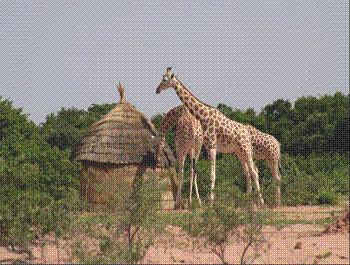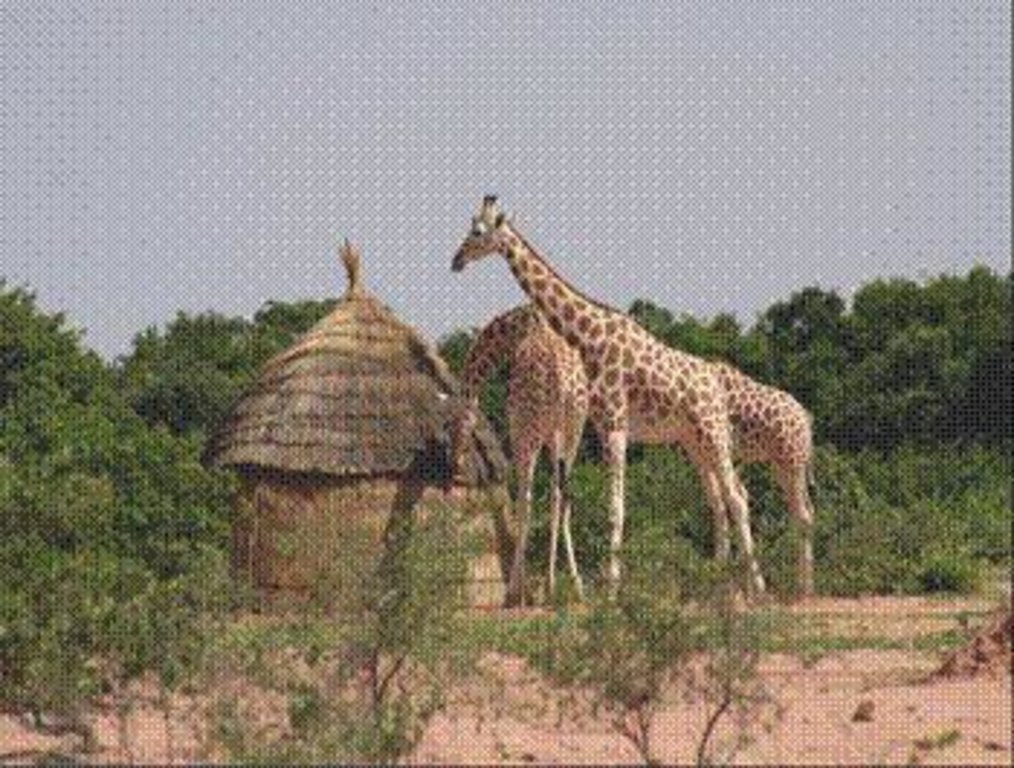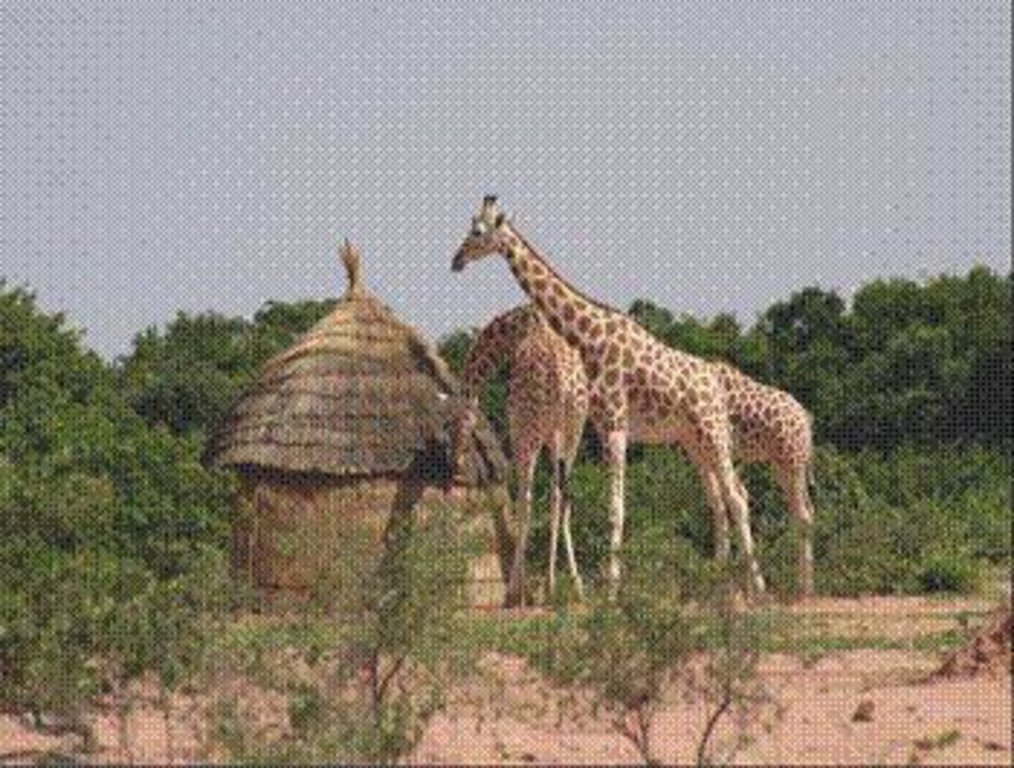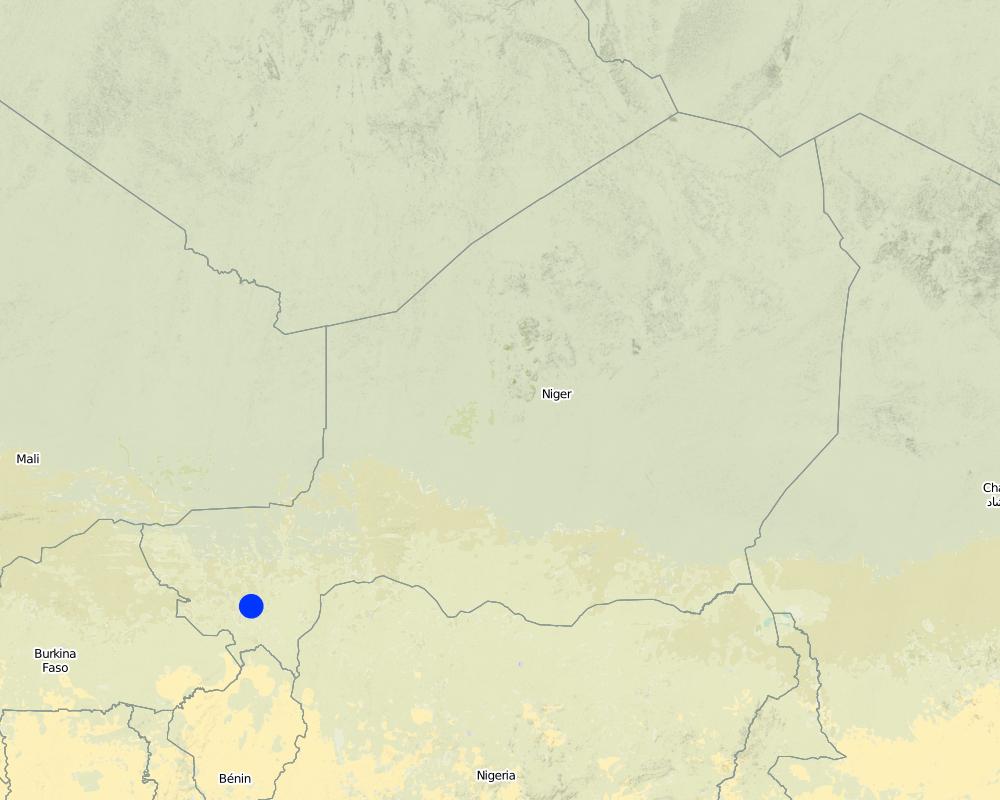Conservation Approach for Kouré Giraffes [ไนเจอร์]
- ผู้สร้างสรรค์:
- การอัพเดท:
- ผู้รวบรวม: Soumaila Abdoulaye
- ผู้เรียบเรียง: –
- ผู้ตรวจสอบ: Fabian Ottiger
approaches_2568 - ไนเจอร์
ดูส่วนย่อย
ขยายทั้งหมด ย่อทั้งหมด1. ข้อมูลทั่วไป
1.2 รายละเอียดที่ติดต่อได้ของผู้รวบรวมและองค์กรที่เกี่ยวข้องในการประเมินและการจัดเตรียมทำเอกสารของแนวทาง
ผู้เชี่ยวชาญ SLM:
Oumarou Ahmed
Ministry of Environment, Niger
ไนเจอร์
ชื่อของโครงการซึ่งอำนวยความสะดวกในการทำเอกสารหรือการประเมินแนวทาง (ถ้าเกี่ยวข้อง)
GREAD (GREAD) - ไนเจอร์ชื่อของโครงการซึ่งอำนวยความสะดวกในการทำเอกสารหรือการประเมินแนวทาง (ถ้าเกี่ยวข้อง)
Ministry of Environment and Sustainable Development of Niger (MINEDD) - ไนเจอร์1.3 เงื่อนไขที่เกี่ยวข้องกับการใช้ข้อมูลที่ได้บันทึกไว้ผ่านทาง WOCAT
ผู้รวบรวมและวิทยากรหลักยอมรับเงื่อนไขเกี่ยวกับการใช้ข้อมูลที่ถูกบันทึกผ่านทาง WOCAT:
ใช่
2. คำอธิบายของแนวทาง SLM
2.1 การอธิบายแบบสั้น ๆ ของแนวทาง
This participatory approach to protect the last population of white giraffes actively involves local people in conservation activities, while simultaneously strengthening local development and promoting ecotourism.
2.2 การอธิบายอย่างละเอียดของแนวทาง
การอธิบายอย่างละเอียดของแนวทาง:
Aims / objectives: The giraffe population in Kouré, Niger is unique because: (1) it includes the last representatives of white giraffes (Giraffa camelopardalis peralta) worldwide; (2) it thrives in an unprotected environment without any natural enemy (besides man); (3) it is in direct contact with rural communities and its livestock. The giraffe, reduced to only 49 individuals in 1996, was in danger of extinction due to a variety of reasons, the main one being the progressive deforestation in their habitat: the brousse tigré savannah vegetation. From 1996-2000, a government programme funded by international development agencies (SNV*, FFEM and the EU) has been carried out to sustainably protect the giraffes and their habitat. This program is based on a participatory approach which actively involves local people in conservation activities, while simultaneously strengthening local development and promoting ecotourism. Its revenues are redistributed to all local actors. A main pillar of the approach was the transfer of responsibilities in natural resources management to local organizations. User groups, a guides’ association, a project steering committee, etc. were formed and its members were trained.
Methods: Tourism and wildlife observation infrastructure was established – including a visitor’s centre, lodging, watch towers, etc – and tourism activities were organized: Guides are trained, registered and organized into an association. They receive a fixed salary and accompany tourists in turns. Furthermore they support project technicians and researchers in monitoring giraffes and collaborate with the network of government-employed foresters, which has been set up to control the conservation of the habitat. Tourists pay an entry fee for wildlife watching tours. The revenues and donations are partly used for management and conservation of the giraffe habitat and partly for socio-economic development of the villages (such as infrastructure projects). These revenues are managed directly by the ‘communes’ (municipalities).
Other important information: Thanks to the protection of the savannah vegetation through enclosures for regeneration, prohibition of cutting and closing down of rural wood markets the giraffe population has recovered considerably, comprising 200 individuals in 2008.
2.3 รูปภาพของแนวทาง
2.5 ประเทศ ภูมิภาค หรือสถานที่ตั้งที่ได้นำแนวทางไปใช้
ประเทศ:
ไนเจอร์
ภูมิภาค/รัฐ/จังหวัด: :
Tillabéri / Dosso
ข้อมูลเฉพาะเพิ่มเติมของสถานที่ตั้ง:
Kouré
Map
×2.6 วันที่เริ่มต้นและสิ้นสุดของแนวทาง
ระบุปีที่เริ่ม:
1996
การสิ้นสุดลง (ถ้าแนวทางไม่ได้ใช้อีกต่อไป):
2000
2.7 ประเภทของแนวทาง
- ใช้โครงงานหรือแผนงานเป็นฐาน
2.8 เป้าหมายหรือวัตถุประสงค์หลักของแนวทาง
The Approach focused mainly on SLM with other activities (health, education, infrastructure, trade, micro-credit, river works, forest surveillance)
Durable and sustainable conservation of the giraffe population in the Kouré area and protection of their habitat; Building organizational and management capacity of the local population for protecting the giraffes; Fight against poverty by offering supplementary revenue to population through ecotourism (diversification of income).
The SLM Approach addressed the following problems: Conflicts between giraffes and local population (damage to crops); Extinction of giraffes; Deforestation (giraffe habitat deterioration); Rural Poverty; Negative perception of fauna by the population; Absence of titled land ownership and of adapted forestry laws
3. การมีส่วนร่วมและบทบาทของผู้มีส่วนได้ส่วนเสียที่เกี่ยวข้อง
3.1 ผู้มีส่วนได้ส่วนเสียที่เกี่ยวข้องในแนวทางนี้และบทบาท
- ผู้ใช้ที่ดินระดับท้องถิ่นหรือชุมชนระดับท้องถิ่น
Women were also involved
- รัฐบาลระดับท้องถิ่น
- รัฐบาลแห่งชาติ (ผู้วางแผน ผู้ทำการตัดสินใจ)
- องค์การระหว่างประเทศ
3.2 การเกี่ยวข้องของผู้ใช้ที่ดินระดับท้องถิ่นหรือชุมชนระดับท้องถิ่นในช่วงต่างๆของแนวทาง
| ความเกี่ยวข้องของผู้ใช้ที่ดินระดับท้องถิ่นหรือชุมชนระดับท้องถิ่น | ระบุผู้ที่มีส่วนเกี่ยวข้องและอธิบายกิจกรรม | |
|---|---|---|
| การริเริ่มหรือการจูงใจ | ไม่มี | Ministries of planning, environment, tourism and artisan, EU, Association of French Volunteers for Progress (AFVP), SNV, beneficiaries. |
| การวางแผน | ปฏิสัมพันธ์ | Kouré Guides Association (AGK), groups of beneficiaries, project advisors and animators |
| การดำเนินการ | ปฏิสัมพันธ์ | Kouré Guides Association (AGK), groups of beneficiaries, project advisors and animators |
| การติดตามตรวจสอบหรือการประเมินผล | ปฏิสัมพันธ์ | AGK, groups of beneficiaries, project advisors and animators, department of Environmental Protection |
| Research | ไม่มี | French Center for Agricultural Research for Development (CIRAD), University of Niamey, National Agricultural Research Institute of Niger (INRAN), International Union for Conservation of Nature (IUCN) and the International Crops Research Institute for the Semi-Arid Tropics (ICRISAT) |
3.4 การตัดสินใจเลือกใช้เทคโนโลยี SLM
ระบุผู้ที่ทำการตัดสินใจเลือกเทคโนโลยีมากกว่าหนึ่งวิธีไปปฏิบัติใช้:
- นักการเมืองหรือผู้นำ
การอธิบาย:
Initiation by the Ministries of planning, environment, tourism and artisan, EU, Association of French Volunteers for Progress (AFVP), SNV, beneficiaries
4. การสนับสนุนด้านเทคนิค การสร้างขีดความสามารถ และการจัดการด้านความรู้
4.1 การสร้างขีดความสามารถ / การอบรม
ได้มีการจัดอบรมให้แก่ผู้ใช้ที่ดินหรือผู้มีส่วนได้ส่วนเสียคนอื่น ๆ หรือไม่:
ใช่
ให้ระบุว่าใครเป็นผู้ได้รับการอบรม:
- ผู้ใช้ที่ดิน
- เจ้าหน้าที่ภาคสนาม / ที่ปรึกษา
ถ้าเกี่ยวข้อง ให้ระบุ เพศ อายุ สถานภาพ ชาติพันธุ์ เป็นต้น:
members of community management committee, land users (women and men), professional guides, advisors
รูปแบบการอบรม:
- กำลังดำเนินการ
- เกษตรกรกับเกษตรกร
- ใช้พื้นที่ทำการสาธิต
- จัดการประชุมสู่สาธารณชน
- จัดคอร์ส
หัวข้อที่พูด:
Conservation technologies and SLM, ecotourism, professional guide skills, organization of associations, accountancy, agriculture
4.2 การบริการให้คำแนะนำ
ผู้ใช้ที่ดินมีการเข้าถึงการรับบริการให้คำปรึกษาหรือไม่:
ใช่
ระบุว่ามีบริการให้คำปรึกษาหรือไม่:
- ไปเยี่ยมชมสถานที่
การอธิบาย/แสดงความคิดเห็น:
Name of method used for advisory service: Dissemination of the approach was by rural animation tools (village planning, rapid PRA, etc.).; The Youth Association for Preservation of Natural Resources (AJPREN), U.S. Peace Corps, AFVP and local departments for Environmental Protection ensured a continuous programme of training, environmental education and awareness raising of guides and local people.
4.5 การวิจัย
การวิจัยเป็นส่วนหนึ่งของแนวทางหรือไม่:
ใช่
ระบุหัวข้อเรื่อง:
- สังคมวิทยา
- เศรษฐศาสตร์หรือการตลาด
- นิเวศวิทยา
ให้ข้อมูลเพิ่มเติมและให้ระบุผู้ทำการวิจัย:
Research had been conducted on-farm in collaboration with local populations. Research topics treated were socio- economical, ecological, technical, giraffe habitat and genetics and agricultural.
Research was carried out on-farm
5. การสนับสนุนด้านการเงินและวัสดุอุปกรณ์
5.1 ระบุงบประมาณประจำปีสำหรับแนวทาง SLM นี้
ถ้าหากว่างบประมาณประจำปีไม่เป็นที่ทราบแน่นอน ให้ระบุช่วงลงไป:
- 10,000-100,000
แสดงความคิดเห็น (แหล่งของการระดมทุน ผู้บริจาคคนสำคัญ):
Approach costs were met by the following donors: international (EU, SNV, FFEM): 100.0%
5.2 การสนับสนุนด้านการเงิน / วัสดุอุปกรณ์ให้แก่ผู้ใช้ที่ดิน
ผู้ใช้ที่ดินได้รับการสนับสนุนด้านการเงิน / วัสดุอุปกรณ์ไปปฏิบัติใช้เทคโนโลยีหรือไม่:
ใช่
5.3 เงินสนับสนุนสำหรับปัจจัยนำเข้า (รวมถึงแรงงาน)
- อุปกรณ์
| ระบุปัจจัยนำเข้าที่ได้รับการสนับสนุน | เห็นด้วยระดับไหน | ระบุเงินสนับสนุน |
|---|---|---|
| เครื่องจักร | ได้รับการช่วยเหลือทางการเงินแบบเต็ม | |
| เครื่องมือ | ได้รับการช่วยเหลือทางการเงินแบบเต็ม | |
- การเกษตร
| ระบุปัจจัยนำเข้าที่ได้รับการสนับสนุน | เห็นด้วยระดับไหน | ระบุเงินสนับสนุน |
|---|---|---|
| เมล็ด | ได้รับการช่วยเหลือทางการเงินแบบเต็ม | |
| ปุ๋ย | ได้รับการช่วยเหลือทางการเงินแบบเต็ม | |
- โครงสร้างพื้นฐาน
| ระบุปัจจัยนำเข้าที่ได้รับการสนับสนุน | เห็นด้วยระดับไหน | ระบุเงินสนับสนุน |
|---|---|---|
| Tourism | ได้รับการช่วยเหลือทางการเงินแบบเต็ม | |
- อื่น ๆ
| อื่นๆ (ระบุ) | เห็นด้วยระดับไหน | ระบุเงินสนับสนุน |
|---|---|---|
| Village development funds and Giraffe habitat management | ได้รับการช่วยเหลือทางการเงินแบบเต็ม |
ถ้าแรงงานโดยผู้ใช้ที่ดินเป็นปัจจัยนำเข้าที่มีอยู่มากมาย ระบุด้วยว่าเนื่องจาก:
- สมัครใจ
5.4 เครดิต
มีการจัดหาเครดิตมาให้ภายใต้แนวทาง SLM หรือไม่:
ใช่
ถ้าใช่ ระบุเงื่อนไข (อัตราดอกเบี้ย การชำระคืน):
repayment conditions: Through village development fund; micro-credit was allocated without interest to women of women groups for agriculture or livestock production. Repayment occurred after six months. After termination of the project, ‘Care International’ continued giving credit however with interest..
6. การวิเคราะห์ผลกระทบและการสรุป
6.1 ผลกระทบของแนวทาง
ช่วยให้ผู้ใช้ที่ดินนำเอาเทคโนโลยี SLMไปใช้และบำรุงรักษาสภาพไว้ได้หรือไม่:
- ไม่ใช่
- ใช่ เล็กน้อย
- ใช่ ปานกลาง
- ใช่ อย่างมาก
Improved sustainable land management: one director for the planning and management of the giraffe area was appointed.
ทำให้กลุ่มด้อยโอกาสมีอำนาจทางสังคมและเศรษฐกิจหรือไม่:
- ไม่ใช่
- ใช่ เล็กน้อย
- ใช่ ปานกลาง
- ใช่ อย่างมาก
financial support to women for agricultural production
Did other land users / projects adopt the Approach?
- ไม่ใช่
- ใช่ เล็กน้อย
- ใช่ ปานกลาง
- ใช่ อย่างมาก
Adoption of Approach by other land users / projects: the ECOsystèmes Protégés en Afrique Sahélienne (ECOPAS) project adopted (2002) this approach which became the basis for national planning action for giraffes in Niger.
Did the Approach lead to improved livelihoods / human well-being?
- ไม่ใช่
- ใช่ เล็กน้อย
- ใช่ ปานกลาง
- ใช่ อย่างมาก
3811 Euros/village had been distributed to the population of 20 villages through village development funds
Did the Approach help to alleviate poverty?
- ไม่ใช่
- ใช่ เล็กน้อย
- ใช่ ปานกลาง
- ใช่ อย่างมาก
creation of 13 permanent guide jobs; 900 woman developed agriculture production for marketing
6.2 แรงจูงใจหลักของผู้ใช้ที่ดินเพื่อที่จะนำ SLM ไปปฏิบัติใช้
- กำไร (ความสามารถ) อัตราส่วนค่าใช้จ่ายต่อผลประโยชน์ที่เพิ่มขึ้น
- การจ่ายเงินหรือการช่วยเหลือ
- well-being and livelihoods improvement
6.3 ความยั่งยืนของกิจกรรมของแนวทาง
ผู้ใช้ที่ดินสามารถทำให้สิ่งต่างๆ ที่ได้ปฏิบัติใช้โดยแนวทางนี้ยั่งยืนได้หรือไม่ (โดยไม่มีการสนับสนุนจากภายนอก):
- ใช่
ถ้าตอบว่าใช่ ให้อธิบายว่าอย่างไร :
After the project was terminated, land users continued this approach without external support based on local development organizations, Association pour la Sauvegarde des Giraffes du Niger (ASGN) and Kouré Guides Association (AGK). Since 2002, the research component is being continued by ECOPAS / EU.
6.4 จุดแข็งและข้อได้เปรียบของแนวทาง
| จุดแข็ง / ข้อได้เปรียบของแนวทางในทัศนคติของผู้รวบรวมหรือวิทยากรหลัก |
|---|
| Populations organization and mobilization |
| Scientific research tools for decision making |
| Economic, financial and ecological impacts |
6.5 จุดอ่อน / ข้อเสียเปรียบของแนวทางและวิธีในการแก้ไข
| จุดอ่อน / ข้อเสียเปรียบในทัศนคติของผู้รวบรวมหรือวิทยากรหลัก | สามารถแก้ไขปัญหาได้อย่างไร |
|---|---|
| Absence of local and national financial contribution | provide regressive grants and promote endogenous funding of activities |
| Uncontrolled fast growth of giraffe population | transfer of giraffes to other protected habitats in West Africa. |
| Approach resulted from exterior initiatives | awareness raising and environmental education to develop ‘conservation behaviour’ in Niger |
7. การอ้างอิงและการเชื่อมต่อ
7.1 วิธีการหรือแหล่งข้อมูล
- ไปเยี่ยมชมภาคสนาม การสำรวจพื้นที่ภาคสนาม
- การสัมภาษณ์กับผู้ใช้ที่ดิน
7.2 การอ้างอิงถึงสิ่งตีพิมพ์
ชื่อเรื่อง ผู้เขียน ปี ISBN:
Oumarou A. 2006. Elaboration d’une stratégie de conservation à long terme de la girafe au Niger, communication à l’atelier sur les girafes du Niger organisé du 22-24 novembre 2006 à Niamey (Niger) par le Ministère de l’environnement et de la lutte contre la désertification en partenariat avec ECOPAS/Union EuropéenneCompte rendu de l’atelier international sur la cogestion faune sauvage et bétail, organisé par Abdoulaye Sambo Soumaila et Marlis Lindecke, DED Niger et GTZ Eschborn, février 2001
ชื่อเรื่อง ผู้เขียน ปี ISBN:
Compte rendu de l’atelier international sur la cogestion faune sauvage et bétail, organisé par Abdoulaye Sambo Soumaila et Marlis Lindecke, DED Niger et GTZ Eschborn, février 2001
ลิงก์และโมดูล
ขยายทั้งหมด ย่อทั้งหมดลิงก์
ไม่มีลิงก์
โมดูล
ไม่มีโมดูล





